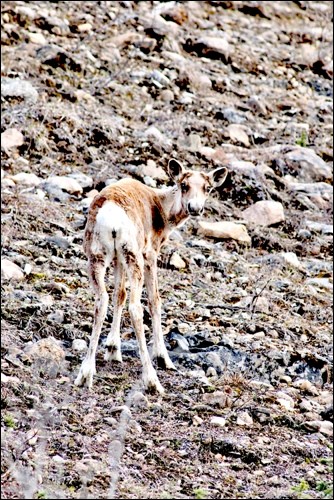Saskatchewan's boreal woodland caribou are in trouble. They have already disappeared from much of their original range, mainly the parkland areas in the southern boreal forest.
Scientific evidence is strong that caribou populations dwindle when large, intact forests are fragmented by human disturbances, which historically have included logging, mining, hydroelectric corridors, seismic lines and agricultural conversion, as well as roads associated with these developments. Such disturbances are now spreading into even the most remote boreal areas.?
Fortunately, the Saskatchewan government is developing a woodland caribou strategy to return our caribou from the edge of extinction. It's still not complete, but properly identifies the need for stronger habitat protection, particularly for ranges under the most pressure in the boreal plain. Meanwhile, the federal government has drafted a national recovery strategy for Canada's boreal caribou, as many populations are in steep decline across the country.
How these two plans align will be crucial to developing effective action plans for Saskatchewan's caribou populations.
Canadian Parks and Wilderness Society is pleased Ottawa's strategy properly identifies human disturbances as the major cause of caribou decline. However, we share concerns that the federal strategy could make woodland caribou recovery in Saskatchewan difficult due to some unique situations.
For clarity, I'll break this down in terms of the boreal shield in Saskatchewan's Far North and the boreal plain in the Nearer North.
A major concern is that Ottawa's strategy fails to set the objective of self-sustaining populations for all woodland caribou ranges. Instead, it targets self-sustainment for certain populations, but not for those most imperilled. The strategy further prioritizes the "not self-sustaining populations," and splits them into those necessary for national connectivity and those that are not.
For Saskatchewan, this could mean that caribou in the boreal shield would be prioritized over populations in the boreal plain. That would be a mistake, since the latter are most stressed and subject to the highest rates of disturbance.
Boreal shield populations are subject to a level of natural disturbance, mainly fire, that exceeds what the federal strategy suggests caribou can survive in. However, woodland caribou have existed in this high fire regime for thousands of years. Less than five per cent of the caribou ranges in the shield has been disturbed by humans.
Adding further complexity is the lack of information on caribou populations and movements in Saskatchewan, which makes decisions much harder.
We know a bit more about the boreal plain, where human caused disturbances are higher (25 per cent on average) and have been a stressor to woodland caribou. Data indicate caribou populations here are declining and immediate recovery actions are necessary.
The federal strategy could be interpreted as suggesting large scale fire suppression in the North, where it is not needed, and a status quo for caribou in the south, where greater habitat protection is urgently needed.
We clearly need a Saskatchewan specific solution. The proposed provincial strategy provides a roadmap. It would prioritize woodland caribou on the boreal plain and recommends more research to fill the significant knowledge gaps.
CPAWS, along with other conservation organizations and forestry companies such as Weyerhaeuser and Tolko, are working to protect Saskatchewan's caribou through the Canadian Boreal Forest Agreement. It lays out a framework for how we will work together with aboriginal communities and the government to develop ideas for recovering caribou and also maintain a strong forestry sector.
Saskatchewan Mining Association members, such as Cameco, have also expressed support for the proposed provincial process, and are investing significant resources into research with the province to study how woodland caribou respond to the high level of fire disturbance in the Far North.
Woodland caribou have yet to be added to Saskatchewan's Endangered Species Act, although there is broad agreement to finalize this. So as we ask Environment Canada for changes in how its strategy considers these uniquely Saskatchewan issues, we must also accept that this in turn increases the responsibility of all involved to help recover the province's woodland caribou. Saskatchewan already is about a decade behind schedule on this issue.
While CPAWS supports this "Saskatchewan made" approach to caribou recovery, we also urge a precautionary approach. While human caused disturbance is still relatively low in the boreal shield, oil sands development will soon change that in portions of the Northwest. Issues on the horizon linked to climate change and infestations such as mountain pine beetles could also increase the frequency of fires in our forests, amplifying the need to learn more about woodland caribou and to act on those lessons.
Preserving the large, intact spaces caribou need means we are also maintaining a healthy forest that allows for all other species, including humans, to exist there as well.
- Gord Vaadeland is executive director of the Canadian Parks and Wilderness Society Saskatchewan chapter.




